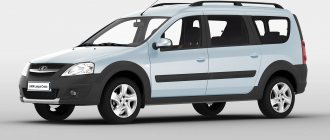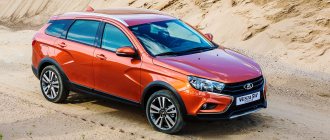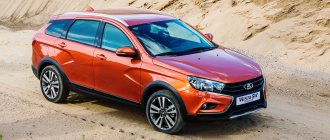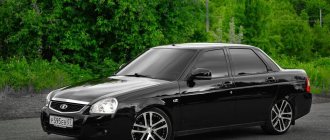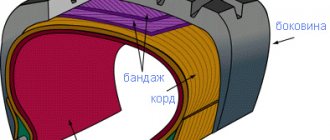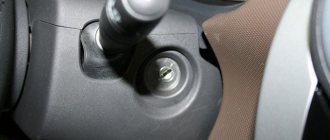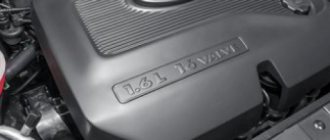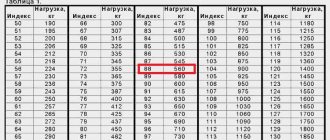Lada Largus Cross 4×4 is one of the most sensational new products in the domestic automobile industry, because this car took all the advantages of Largus, to which tuning was added: all-wheel drive and increased ground clearance. The model was released at the end of 2014, and we can already safely say that the car is becoming popular in the domestic car market. The car perfectly withstands all the “delights” of our roads, rarely breaks down, and finding spare parts for this Lada is easy.
Descriptions and technical characteristics of Lada Largus cross 4×4
Lada Largus Cross 4×4 is one of the most sensational new products in the domestic automobile industry, because this car took all the advantages of Largus, to which tuning was added: all-wheel drive and increased ground clearance. The model was released at the end of 2014, and we can already safely say that the car is becoming popular in the domestic car market. The car perfectly withstands all the “delights” of our roads, rarely breaks down, and finding spare parts for this Lada is easy.
Let's touch on the history of the Lada Largus car
The appearance of the Lada Largus 4x4 model with all-wheel drive on the market took place in 2012. At that time, the car had front-wheel drive and was adapted to harsh domestic road conditions.
The progenitor was the popular practical station wagon of European origin “Dacia Logan MCV” in its first generation (since 2006).
The model was available to the buyer in three versions:
- five-seater station wagon;
- its modification with seven seats;
- cargo version "van".
The car was designed using the “B0” platform, popular at that time.
For all variations, a 1.6-liter engine was available as the driving force. Its modifications consisted of different designs of the valve mechanism (8 or 16 valves), as well as its own settings.
The 8-valve unit had two versions that differed in power: 84 and 87 “horses”, and the engine with 16 valves already generated 102 “horses”.
All units were equipped with five-speed mechanical transmission units.
The maximum speed was 165 km per hour, and fuel consumption per “hundred” kilometers on average did not exceed 9 liters.
The buyer immediately appreciated the new car due to such points as:
- attractive exterior;
- ergonomic and spacious interior;
- spacious luggage compartment.
The increased popularity allowed the manufacturer to seriously think about building a version with all-wheel drive that could compete with crossovers.
Bo Inge Andersson, who at that time held the post of president of AvtoVAZ, actively participated in the discussion on this promising area. The developers purposefully built a more comfortable version of the LADA Largus VIP for it. The car had increased power, reaching 135 “horses”. This step allowed us to test the potential of the enterprise in terms of its ability to produce modifications belonging to a higher class.
Replacing fog lights Largus
Wipers Largus
Lada Largus load capacity
Performance characteristics and changes
The main difference from the previous version of this model is all-wheel drive. This tuning allows you to overcome obstacles, off-road driving, and just feel confident on the road much better. However, such an improvement did not affect the amount of fuel consumed. The car cannot be called economical, but for an all-wheel drive car the performance is quite good. In the city, consumption is 11 liters per 100 km, outside the city 7.5 liters, and in mixed mode 9.5. It is recommended to fill the tank with gasoline with the highest octane number, because it allows the engine to reveal all its capabilities, pleasing the driver with decent speed.
Another change compared to the classic Largus is the increase in ground clearance. Without any special load, it is about 20 cm, but when fully loaded, the clearance is 17.5 cm. Such tuning serves to increase comfort in the cabin, because
Now the car passes any obstacles much smoother, which is very pleasant for both the driver and passengers.
In general, the characteristics of the car have been improved, which contributes to the high demand for Largus Cross 4x4. Apart from the fact that this car has all-wheel drive and increased ground clearance, there are no huge changes, but the manufacturer has clearly worked on the details, which concerns not only the interior, but also the “stuffing” of the hood.
Lada Kalina 4x4: it was and is now
Lada Kalina 4x4 model 2007 – Subframes and transfer of the spare wheel – Front-wheel drive Lada Kalina Cross is announced, but not produced – Baburin enters the scene – All-wheel drive by simple means
To begin with, I will give a short quote from the VAZ report for the 3rd quarter of 2013:
The Company's activities may be affected by a shift in demand towards premium brands and an increase in demand in the SUV and CUV segment with a simultaneous decrease in sales in classes B and C. In order to minimize the negative consequences of this risk, it is planned to develop and produce pseudo-crossover versions based on the existing LADA model range.
Development is planned... There is an abyss of deceit in this phrase. The fact is that a crossover based on Kalina began to be developed immediately after the model was put into production, in 2005. By 2007, the all-wheel drive Kalina was ready, it was even shown at the Moscow Motor Show.
Then I talked to one of the VAZ engineers, Valentin Vlasov:
Valentin Vlasov
He talked a little about the principle of all-wheel drive.
All-wheel drive design of Kalina 4x4 2007
In short, the car was fitted with an angular gearbox attached to the VAZ-21113-04 gearbox,
after which the shaft transmitted torque to the GKN silicone coupling, and then to the Nivov gearbox. The rear suspension is on the original subframe.
The exhibition car had a 21128 1.8/98 hp engine, and the main gear was “increased” to 4.3.
Here are photos from VAZ's description of this car. It can be seen that the “conflict” between the rear suspension on the subframe and the niche for the spare tire is inevitable. But VAZ found an opportunity to “make friends” with them by moving the niche back to the rear frame:
And here’s what the power take-off gearbox looks like from below:
And the all-wheel drive clutch:
Modified gas tank:
The single-drive version was held at the Scientific and Technical Center under the name Kalina Cross XM-001. Here are her four initial options:
Option 1. Tires 185/65R14 (from Priora). Rear drum brakes, ABS. The estimated increase in ground clearance compared to the standard Kalina is 28 mm (20 mm due to shock absorbers, 8 mm due to the static radius of the tires).
Options 2 and 3. Tires 195/55R15 (Kama-Euro-236). Rear disc brakes, without ABS. The estimated increase in ground clearance compared to the standard Kalina is 30 mm (20 mm due to shock absorbers, 10 mm due to the static radius of the tires).
Option 4. Tires 195/55R15 (Kama-Euro-236). Rear disc brakes, without ABS. Compared to option 3, additional elements were introduced between the body and suspension, which increased the ground clearance by 53 mm at the front and 58 mm at the rear. In the VAZ report in relation to this option there is the following phrase: “inadmissible contacts of the body with the suspension elements were recorded.”
Alas, Kalina Cross did not receive any “final version”, with any type of drive. It could have been produced in the OPP, but the amount of modifications to the base vehicle turned out to be large, and the design turned out to be expensive.
In addition, Kalina Cross found itself at the very peak of the plant’s feverish rushing in search of a strategic investor; there were almost no free funds, and in 2008 there were none at all.
Thanks to Mr. Artyakov, who mediocrely led VAZ at that time and was fired with a fantastic “golden parachute” of 1.5 billion rubles. This money would be exactly enough for Kalina Cross...
They returned to the topic of a crossover based on Kalina in 2009, making the first sketches of a new car, which would later become Granta and Kalina-2. Already at the time of the presentation of Grants, VAZ had solutions for a front-wheel drive crossover on this platform.
Naturally, with an eye on the updated Kalina. That is, a station wagon or hatchback with increased ground clearance and a plastic body kit (a la Sandero Stepway). We considered different levels of ground clearance, raising the car by 30 and even 50 mm.
They were looking for a compromise between increasing cross-country ability and cost: every additional millimeter of ground clearance brought the need for more and more improvements.
We more or less settled on an increase of 18 mm, this made it possible to raise the car with minimal means, using standard “Kalinovsky” wheel drives.
But... The project for the production of such a machine was canceled by the OPP in 2012. Some say that VAZ’s French partners opposed the project (the pseudo-crossover Kalina would have taken away some of the buyers from Stepway).
According to another version, they decided to make the model at the main production facility, at SKP, it was the idea of Oleg Grunenkov, director of the Kalina/Grant/Datsun project. But something didn't work out.
Although Igor Komarov stated at least twice during 2013 that the Kalina CUV is ready and the plant is only waiting for the go-ahead from marketers: they say, there will be demand, we can start.
In general, the whole of last year passed in tense anticipation, fueled by the media, which remembered Kalina Cross for every reason and without it. Against the background of these expectations, Alexander Baburin, head of the Togliatti company Avtoproduct, decided to offer his version of the Kalina crossover.
Baburin
Alexander Baburin
I have already briefly mentioned Alexander Baburin. This is a former VAZ designer who at one time even managed to work as the director of SeAZ (for a short time).
At VAZ he worked on suspensions and all-wheel drive; he worked under Vladimir Guba, including in the sports car department. He rose to the rank of lead designer.
The above-mentioned all-wheel drive Kalina is largely his work; it was also created under the leadership of Guba, as well as all-wheel drive vehicles based on the “Ten”, the integration of the Opel engine into the 2123 and the “Ten”...
Now Baburin, within the framework of Autoproduct, develops and produces various tuning hardware for VAZ cars - stretchers, subframes, brackets, levers... But this is all momentary, but the maximum task is to develop an SUV of our own design with a plastic body (in collaboration with Togliatti designer Vitaly Ivanov) . But there is no investor for the SUV yet. Therefore, Alexander took on an “interim” project - a crossover based on Kalina, in two versions - 4x2 and 4x4. Since VAZ can’t decide on this.
The guys from Autoproduct have prepared a full range of solutions that will allow you to convert a standard Kalina into a CUV with relatively modest efforts. These are new front and rear suspensions plus an all-wheel drive design. This is what the hanging solution looks like in metal. The design of both suspensions is McPherson.
Front suspension on subframe:
This is how Alexander himself talks about it.
By making the front suspension a single module on the subframe, we increase the rigidity of the entire structure, which improves handling. Even with such an archaic steering rack mounting as in Kalina. If it were possible to move the steering to a subframe, the accuracy of the reactions would increase revolutionarily. But - alas...
The front subframe adds a little more than 15 kg of weight to Kalina. For the 4x4 version this is even a benefit, as it compensates for the weight of the rear gearbox.
Rear suspension on subframe:
This is a unified design and can be used for both types of drive. Unless for a 4x4 there will be room to hang the rear gearbox. Let's listen to Baburin:
Springs and shock absorbers will also be “their own”. I put this word in quotation marks, since Avtoproduct does not have the capacity to produce such parts; you will have to order from a third-party supplier, but according to your own specifications. In principle, the St. Petersburg Plaza is already making a number of original single-tube sports struts for Avtoprodukt, but for the Kalina CUV the order will most likely be placed at another plant.
Engine technical parameters
First, let's take a look at the car's engine. It is located transversely in the front part, which has long become a classic for domestic and world mechanical engineering. Details about the motor itself:
- engine brand K4M;
- 4 cylinders;
- working volume is 1600 cubic meters. cm;
- engine power is 102 hp. s., or 5750 rpm;
- torque is 3750 rpm.
So, the car is equipped with a really good engine, which is quite capable of satisfying the driver’s needs both in the city and on country roads. The maximum speed that this all-wheel drive vehicle can reach is 165 km/h. Acceleration from 0 to 100 km/h takes a little more than 13 seconds. We can say that for its class the car demonstrates good technical and dynamic characteristics. Of course, you won’t break speed records with it, but you will feel confident in the traffic.
Safety
No one hides the fact that, in essence, the Lada Larguss cross is the heir to the French RenoDacio. The car has excellent prospects on the Russian market: it is very practical, roomy, with an excellent interior and a good chassis. Of course, there are options for modernization. In the future I would like to see an all-wheel drive version, a more powerful engine, an “automatic” or “robot”. It wouldn't hurt to work on safety, too. In crash tests, overall driver safety was rated three points. In a frontal impact at a speed of 64 km/h, the driver's legs are at greatest risk; the airbag, on the contrary, does an excellent job and completely protects the head. The situation is much worse with a side impact. Due to weak lateral protection, there is a very high chance of breaking ribs. EuroNcap gave the car three out of five stars. If we evaluate safety using other methods, taking into account penalties, then Largus cross is unlikely to get even two stars. So we can say that this car is by no means a safety standard.
Body and “filling” of the car
The Lada of this model has a rather stylish body, although some note some angularity in the rear. However, it looks quite organic, so this car can be called aesthetic and harmonious. Here are some
| Body characteristics | Peculiarities |
| A station wagon. It has the classic 5 doors for this type. | Sufficiently roomy trunk. |
| Trunk volume. | 560 cm cube |
| There are 5 seats in the cabin, which can easily accommodate 7 people. | It is for its good carrying capacity and ability to transport a considerable number of passengers that this car is recognized as very practical and convenient. |
| The vehicle dimensions are as follows: 4470/1756/1682. | Largus looks a little long, but this can be called a feature of all station wagons. This feature does not in any way affect the ease of movement around the city; it is convenient to maneuver. |
| Machine weight. | Is approximately 1300 kg. |
| The car is available in different colors. | From metallic to blue and red. |
Manual transmission TL8, 6 speed.
This transmission was developed on the basis of the TL4 and was intended for 4X4 Renault-Nissan models.
A hydraulic clutch drive, two flexible control cables, a twin-shaft system and synchronizers in all gears, including reverse - this is the design of the TL8. The driveshaft is connected through a gearbox and transmits torque to the rear axle. All-wheel drive is activated from inside the cabin when the switch closes the electromagnetic clutch.
The TL8 is equipped with engines developing up to 240 Nm of torque. Among the features is a short first gear, which owners often use as a reduction gear when off-road.
The resource of TL8 is about 150 thousand, and this, of course, is not much. But if you change the oil every 60 thousand and do not participate in off-road racing, you can actually extend the life of the unit by 2-3 times.
As for characteristic malfunctions, the TL8 sometimes howls spontaneously, according to complaints from owners. There are also oil leaks through seals and gaskets. There have been cases of transmission destruction at ridiculous mileage, but, as a rule, they are associated with gross errors during assembly at the factory, such as underfilling the unit with oil.
- The three most reliable Renault engines, read
- 3 most unsuccessful Renault engines, read.
Exterior changes
The all-wheel drive Largus has been restyled, affecting mainly the front part of the car. The off-road profile was achieved through the applied facelift technologies:
- Side plastic body kits and inserts on wheel arches made of durable plastic protect the body from chips and scratches.
- Updated design of the radiator grille with the AvtoVAZ logo placed on it.
- 16-inch alloy wheels that improve the stability and handling of the crossover.
- New front bumper design and angular body lines.
Interior trim
The color scheme of the interior in Largus Cross repeats the decoration of the Lada Kalina Cross. To the bright orange elements of the inserts in the design of the upholstery of the seats, doors, and those located on the control panel, there was added stitching of the seams with threads of the same color and a leather insert in the passenger seats in the upper part. Also applied to the plastic of the threshold overlay. The spare wheel has moved from the luggage compartment to the bottom of the car.
Specifications
From a technical point of view, no special changes were made to the all-wheel drive Largus:
- Five-speed manual transmission. Provides smooth gear shifting and has a convenient digital mechanism.
- The brake system consists of two independent circuits, which, due to their diagonal arrangement, can replace each other in the event of failure.
- Easy to use cooling system.
The all-wheel drive Largus is equipped with a 16-valve engine with a capacity of 105 horsepower and a volume of 1.6 liters. It is paired with a five-speed transmission. The acceleration dynamics are 13 seconds. Maximum speed is 165 km/h, average fuel consumption is 9 liters per 100 kilometers.
Chassis and engine
So far, the Lada Largus cross is available only in a front-wheel drive version, so it cannot pretend to be a full-fledged SUV. The engine is a 4-cylinder, with 16 valves and a volume of 1.6 liters. The maximum power of the car is 105 “horses”, which it will develop at 5750 rpm. When the car is fully loaded, the dynamics remain at a fairly high level, however, miracles do not happen and the 1.6-liter engine makes its presence felt.
The gearbox is five-speed, gears are engaged clearly and confidently. There are no questions about this car. In the future, it is planned to release Larguscross with an automatic transmission, but for now we have to be content with what we have.
European engineers were involved in the development of the chassis. This car was equipped with the “indestructible” RenoLogan suspension, which in the end turned out to be the right decision. At the same time, the shock absorbers were lengthened and different springs were installed. This made it possible to maintain maneuverability. 12 Despite the overall length of the car (4470 mm), the car does not roll when cornering and there is still room for maneuver even during sudden lane changes. In general, the suspension is quite rigid, which allows you to “jump” over potholes. Although it should be noted that the dynamics are still lacking, we should not forget that this is still a domestic car. By the way, some people get out of this situation by modifying the throttle, increasing the passage opening. It is worth saying that this modification is dubious and reviews vary greatly from laudatory to complete dissatisfaction. It makes sense to do this only if the car will be used exclusively in the urban cycle; there is an opinion that at speed the car stops “pulling”.
There are minor complaints about the braking system. The car does not always respond adequately to the brake pedal. I would like to get more responsiveness when pressing this pedal.
A rare case for a budget station wagon, especially a Russian-made one - nothing rings or rattles in the cabin, the rear part of the cabin does not live its own life.
The engine is almost inaudible when driving. Overall, the sound insulation of this car leaves a pleasant impression. Fuel consumption in the combined cycle is about 10 liters per 100 kilometers. In principle, the result is not bad, although it could be lower. The manufacturer recommends refueling with gasoline of a quality no less than AI-95, which will undoubtedly affect the cost of maintenance.
Interior
Official dealers, as we have already said, offer the Lada Largus Cross for 5 seats and for 7 seats. The interior layout is in many ways reminiscent of the universal version of the crossover, equipped with comfortable wide seats, ergonomic controls and additional shelves for small items.
Changes in the interior design are visible to the naked eye: leather inserts in bright colors have appeared on the center console and door panels, all seats are equipped with comfortable headrests. There are three-point seat belts. The design of the driver's seat is equipped with lumbar support. The steering wheel can be adjusted to its maximum vertical position.
The safety system of the all-wheel drive Largus is similar to that on European cars and is represented by airbags for the driver and front passenger, and side airbags that protect against injury in the event of a frontal collision.
General information
In February 2015, sales of the new domestic car Lada Largus Cross successfully started. Its technical characteristics exceeded many, even the wildest expectations. The new product was liked by the owners who managed to purchase this car. The main version of the car is built on the B0 platform and is based on the good old Reno Logan. The car differs from its classmates not only in price, but also in some other data. The suspension has an excellent safety margin, and allows for operation not only on good asphalt, but also in severe off-road conditions. The ground clearance increased to 260 millimeters (at the level of the bumper) allows you to avoid all kinds of damage to the paint coating. Plastic linings perfectly protect the bottom. When traveling on country roads, the risk of damage to the lower part is minimized.
The configurations of the Lada Largus cross are also pleasing. Initially, it is supplied in the “standard” version, but is fully equipped: ABS, driver and passenger airbags, air conditioning, heated seats, electric mirrors, a tape recorder, fog lights, power windows, an on-board computer and roof rails.
Comfort of movement
Regardless of the price and configuration, the Lada Largus Cross 4x4 is equipped with an independent front suspension and a semi-independent rear suspension, which ensures the comfort of the crossover:
- Elimination of outside noise while driving.
- Smooth ride when driving on uneven road surfaces.
- Increased passability on country roads.
- Maintains excellent handling and maneuverability in urban areas.
The reinforced body and frame increase the level of safety when driving at high speed.
JH3 and JR5 gearbox
Depending on the configuration, the car is equipped with five-speed JH3 and JR5 gearboxes, made according to a two-shaft design with synchronizers for all forward gears and combined with a differential and final drive. Transmission fluid is poured into the gearbox at the factory, which is designed for the entire service life of the vehicle. Therefore, there is no need to change the gearbox oil according to maintenance schedules.
Gearbox JH3: 1 — rear gearbox cover; 2 — clutch cable bracket; 3 — clutch fork; 4 — gearbox housing; 5 — breather fitting; 6 — gear shift mechanism; 7 — cavity for the speed sensor; 8 — shaft of the right side differential gear; 9 — clutch housing; 10 - input shaft; 11 — boot; 12 — holder for electrical wires; 13 — oil filler cap; 14 — housing of the internal hinge of the drive mechanism of the left wheel; 15 - reverse light switch
The car engine, like all internal combustion engines, develops power and torque in a relatively narrow speed range. As engine speed decreases, power decreases
The power transmission allows you to reduce the number of revolutions of the drive axle in relation to the number of revolutions of the engine crankshaft, increasing traction force. The higher the traction force, the lower the speed.
When driving a car, it becomes necessary to use different speeds and different traction forces. For example, when driving through deep sand, the speed is insignificant, and a fairly large traction force is required to overcome the resistance of the road. Great traction force is also required when starting the car and overcoming steep inclines. On the contrary, when driving on a paved road, little traction is required, but the speed of movement can be high.
To increase or decrease the traction force on the drive axle while maintaining a constant torque on the engine shaft, a gearbox is used in the vehicle's power transmission.
Due to the fact that the engines of different car models have different power, then, of course, the gear ratios of individual gears, and, consequently, the number of teeth of the gears are different. However, the operating principle of the gearboxes is the same, and the disassembly, assembly and repair operations are generally similar.
The purpose of the gearbox is to ensure further conversion of torque in magnitude and direction in accordance with the load on the vehicle, as well as to enable the engine to idle.
The basic principle of operation of the gearbox is the same everywhere, the essence of which is the pairwise connection of gears that have a different number of teeth. In this case, the torque transmitted by the gears changes in proportion to the gear ratio, i.e. The ratio of the number of teeth on the driven gear to the number of teeth on the drive gear.
A gearbox is, in principle, a very simple device.
Gearbox control mechanism: 1 – bushing (the gearbox control rod is connected to it); 2 – gearbox lever retainer; 3 – gear shift lever (has a ball bearing that is inserted into the body); 4 – lever handle; 5 – plastic body
Gearbox control rod: 1 – coupling bolt; 2 – clamp; 3 – nut; 4 – traction; 5 – traction finger
The rod is attached at one end to the bushing of the gearbox control mechanism, and at the other end to the shift mechanism installed on the gearbox.
Gearbox JR5
Gearbox JR5: 1 — input shaft; 2 — right wheel drive oil seal; 3 — clutch housing; 4 — gearbox housing; 5 — back cover; 6 — breather fitting; 7 — eye-bracket; 8 — gear lever; 9 — gear selection lever; 10 — speed sensor or plug; 11 — bracket for fastening transmission control cables; 12 — left wheel drive oil seal; 13 — reverse light switch; 14 — oil filler cap; 15 — tube for supplying fluid to the working cylinder of the hydraulic clutch; 16 — clutch release bearing
Cargo dimensions
The restyled version of the all-wheel drive Largus is available in two versions - five- and seven-seater, differing in the interior layout and luggage compartment volume. Folding seats allow you to quickly transform the seven-seater model into an all-terrain station wagon with all-terrain capability and spaciousness. The crossover is equipped with powerful roof rails and an additional luggage basket. The ability to load large items is available thanks to the hinged rear doors.
The five-door design greatly facilitates access to the cabin for third-row passengers. The cargo model of the all-wheel drive Largus allows you to load items through the side door.
Configurations and prices of Lada Largus Cross 4x4
Official dealers offer two trim levels of the crossover, the price of which directly depends on the engine and option package. The restyled version of the crossover in the basic configuration is considered budget and is equipped with front-wheel drive.
A car with a five-seater configuration will cost motorists 674 thousand rubles. The version is equipped with a five-speed transmission and a 1.6-liter engine. The five-seat crossover option package includes the following:
- Front and side airbags, power steering column, leather steering wheel upholstery, wide steering column adjustment range.
- Fog lights, air filters, door moldings.
- On-board computer, ABS system, parking sensors.
- Electric windows, central locking.
- Standard audio system with USB and AUX connectors.
- Air conditioning, heated mirrors and front seats.
What gearboxes are installed on the Lada-Largus
In general, all internal combustion engines (ICEs) have the same drawback - insufficient adaptability to vehicle operating modes. The internal combustion engine is capable of developing power and torque in a small crankshaft speed range. Moreover, with a decrease in the number of revolutions, the developed power decreases.
During operation, the car moves at different speeds and requires varying torque. For example, when starting from a stop, the speed of the car is low, but the traction force must be large. On the contrary, when moving on a good road, the car develops high speed without requiring much traction force.
In order to ensure a change in the magnitude and direction (reverse movement) of the torque at constant power of the power unit within a wider range, a gearbox is used. In addition, with the help of a gearbox, the engine and drive wheels are disconnected for an unlimited time and, unlike the clutch, without the participation of the vehicle driver.

